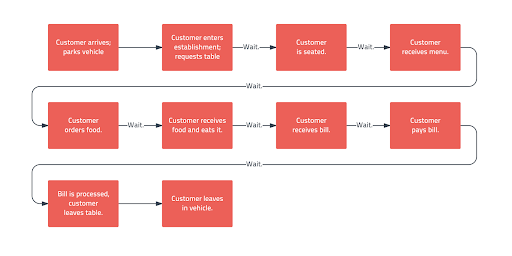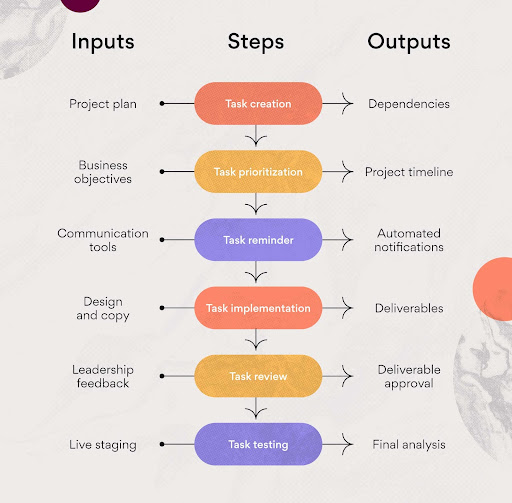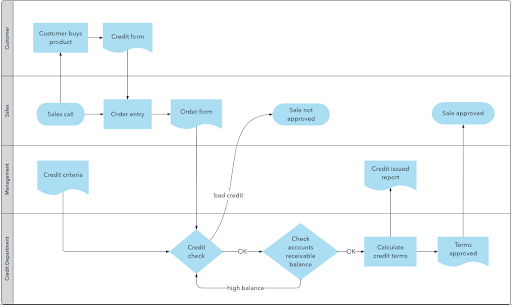Summary
Are you struggling to manage your business process? We can lend a hand. Process documentation is a step-by-step instruction you assign to staff for carrying out tasks effectively and it outlines the entire process from beginning to end.
When your business expands, you get more and more moving parts and it’s someone’s job to keep track of the complexity. People and tasks need to be organized in the most productive way possible and you have to find some way of letting staff know how to carry out the processes needed to do their jobs effectively.
To make a process repeatable it needs to be documented. Someone needs to write down your organizational knowledge so it is accessible to everyone instead of held in the heads of a few. The expectation that staff will be able to guess what to do and that processes will naturally fall into place is an error.
Without process documentation, your company is in the dark when it comes to carrying out tasks. Everyone is winging it and this is a problem when it comes to company growth and taking the business to the next level.
What is Process Documentation?
Process documentation is a step-by-step instruction on how to complete a process from beginning to end. Process documentation is intended to record information that would otherwise remain inside the heads of individual employees and result in haphazard execution.
It introduces some accountability to those employees who are attempting to carry out the documented process. Employees have access to an objective standard and can define whether or not they have been successful in executing the process.
An example of a process could be onboarding a new employee, or how to handle a customer complaint.
Also Read: Best Process Documentation Software
Why Company Operations Rely on Process Documentation
Operational superfluity
When you’re forced to document your processes you sometimes realize steps are unnecessary to the task at hand. Your operations become more streamlined as you cut the processes down to the bare minimum that your employees need to complete the task. You may even decide that an entire process could be eliminated, leaving your employees more time to devote to more productive tasks.
Change management
When managing change in your organization it can help to document your processes so employees know what is expected of them. You have a record of the changes you want to implement and so it becomes easier to hold employees accountable. One of the most important parts of change management is communicating the required change to your employees so they can successfully implement your vision.
Record of protocols
Process documentation means you have a record of the protocols your employees need to follow so you can ensure compliance. Making your protocols explicit is the first step to guaranteeing consistency that results in a high-quality outcome, every time.
Reducing the risk of operational damage
When employees don’t have process documents to follow this increases the chances that they will make mistakes, resulting in costly operational damage. In your process documentation, you can highlight the key areas where mistakes are likely to be made so your employees are warned ahead of time and less likely to make them.
Improve operational efficiency
When you document your processes you can easily find places where your processes can be automated, and invest in the right tools that will help you make them more efficient. You’ll save valuable time and effort in automating routine tasks so your employees are freed up to take on more meaningful work.
Secure intellectual property
Your processes are your intellectual property and part of what sets you apart from the competition. It’s important to document your processes so you can retain them for the future and guarantee that the knowledge isn’t lost when key employees leave the organization.
Ramifications of Unstructured Documentation
Inefficient operation
Undocumented processes result in employees having to guess about what is expected of them and potentially taking much longer to complete processes than is strictly necessary. Process documentation tells employees exactly what to do so they can be more efficient when carrying out their tasks.
Missed revenue opportunity
Without process documentation this means employees will be less productive and your company will be losing money as employees struggle or miss out on completing vital tasks. When employees don’t know what to do you might risk them leaving the company altogether, resulting in a loss of revenue for your business.
Loss of critical information
Process documentation provides a record of vital information known only to one or two employees. You risk these employees taking that knowledge with them when they leave the company, but process documentation can capture that knowledge and preserve it for the future. Without process documentation, vital knowledge is lost forever.
Can’t adapt to change management
If you don’t document your processes you can’t communicate to employees when they need to make changes, and your change management initiatives may fail. Employees will keep doing things the way they have always done them and your organization will be less adaptable, risking that you will fall behind the competition.
Poor job satisfaction
Employees will have lower job satisfaction if you don’t document the task they are supposed to complete as part of their job. Employees might be confused about who is responsible for what and decide they want to work at a company where they are better appreciated. Documentation is investing in your workforce and ensuring that everyone has the resources they need to do their jobs properly.
Reinventing the wheel
If a process is undocumented that means the process has to be reinvented every time. Employees have to guess about the steps needed to complete the process and they might end up executing work that has already been done by someone else. This is hugely inefficient and a waste of employees’ time.
How to Write Process Documentation
Define your goal
Before you can get started with your process documentation, you must first work out what you want to achieve with this project. For example, is it to reduce the amount of time employees spend searching for information to do their jobs? Is it to make employees more productive by eliminating the need for guesswork in carrying out their day-to-day tasks? Is it to enhance communication between departments by presenting clearly-defined roles?
You will likely have several goals for your process documentation. Get clear on your objectives and this will help you decide on which processes you want to document first.
Gather your documentation team
Process documentation is a team sport. No one person can put together a whole organization’s documentation by themselves – that would be overwhelming and impossible to achieve. Gather a team together composed of documentation champions who can lead the charge in developing your team’s process documentation.
You’ll need a mix of writers and editors who can produce documentation up to the highest standards. Ideally, your company should employ professional technical writers who have experience in preparing documentation. Sometimes, the best person to document a process is the one who is using it every day, so consider this when deciding which stakeholders to get involved.
Research on tools and requirements
It’s impossible to launch a process documentation strategy if you don’t have the right tools in place. There are a range of documentation tools out there and SaaS solutions like Document360 can be implemented straight away. Make sure to conduct your research and settle on a tool that is suitable for your company and its unique needs.
With Document360, you can decide on the number of users who you want to have access to the software and define roles that control how users interact with the documentation. It helps you form a process for creating the process documentation and ensure that every user knows their place in the production line.
Leaves no room for errors by documenting your procedures!
Book a Demo
Design a template
When creating your documentation, it’s important to come up with a template that you can use to guide the creation of all future documents. This means that no matter who is in charge of creating technical documentation, you’ll have a uniform standard and you’ll enforce consistency. Templates should be simple and easy to follow, including all the essential information that should be added to the document.
Write your documentation
- Step one: Identify and name the process – decide on your process’s purpose, why and how the process will benefit the company, and briefly describe the process.
- Step two: Outline the process scope – briefly describe what is included in the process and what is not.
- Step three: Detail the process boundaries – where does the process start and finish? What causes it to begin and what is the indication that it’s done?
- Step four: Capture the process outputs – what is the end result of the process once it has been completed?
- Step five: Capture the process inputs – what resources are needed to complete the process?
- Step six: Collect the process steps – note down each step in the process either starting with what triggers the process, or starting with the end result and working backwards.
- Step seven: Include everyone involved – provide a description of everyone involved in the process using their job title.
Add visuals
A picture is worth a thousand words. After you have written your process documentation, make sure to illustrate it with images like flowcharts, which can really bring your document to life. Employees will find it easier to understand a process when it is represented visually and you can clearly document every single step.
Peer review
Just before your documentation is published, make sure it undergoes a peer review process where you gather feedback from other people in the company. It’s important to find out whether employees are finding your documentation useful and if the processes are easy to follow.
Some of your steps may be confusing or employees may be unsure who is responsible for a particular task. A peer review can make your documentation much clearer and ensure that it is hitting the target.
Publish the document
Once you’ve finalized the documentation it’s time to make it available to the rest of the organization. Your chosen documentation tool should allow you to publish private documentation that is available only to the employees in your company, keeping your documentation secure and protected from unwanted visitors.
Audit the performance
When your documentation is published, your documentation tool should allow you to track the performance of your content. Identify which articles get the most views and make sure they are easy to find within your system. Collect feedback from your employees about whether they find the documentation helpful and use it to make appropriate changes. Some documentation might be more useful to your employees than others.
Also read: DocOps: Consistent Documentation for your Business Success
Useful Tools in Process Documentation
Knowledge base tool
Check out how a knowledge base tool can be used to document processes
Knowledge base software like Document360 offers a centralized repository of information that you can use to store your process documentation and make it available for a select group of users. Get started straight away publishing your articles using Document360.
Document360’s intuitive features
- Easy editing – WYSIWYG editor or Markdown editor. Allows the editor to add illustrations, flowcharts, and videos
- Version Control- The software automatically saves versions of your articles so you’re never in danger of losing your work, and you can revert back to a previous version at any time.
- AI-Powered Search- Enables the users to quickly search the required information without wasting time.
- Organizing Content- The documentation can be organized more clearly as nested articles in a category.
- Customization- Enables editors to customize the platform to match your company brand.
- Sharing and Collaboration- With Document360 you can communicate and collaborate with team members on peer reviews and sharing the articles.
- Integrations and extensions- Document360 can be integrated with multiple cloud servers and apps that you and the team will use on daily basis.
Streamline your process documentation with intuitive knowledge base software that integrates with any application. Try Document360!
GET STARTED
Process workflow management Solutions
Process workflow management solutions like Process Street allow you to easily manage your team’s recurring processes. You can track your progress and collaborate with your team. The simple interface lets you create structured documents in seconds and the checklists let you keep track of the steps in your processes.
Video and screen recording tool
You might want to add video and screen recordings to your documentation using a tool like Snagit. Snagit allows you to quickly capture your screen and your camera and add additional context so you can make highly engaging videos for your users. You’ll be better able to illustrate how to perform an action for your users if you can make an accompanying screen capture.
Flowchart & diagramming tools
Flowchart and diagramming tools like Lucidchart allow you to make visual representations of your processes that are easier for your employees to understand compared to just text. You can quickly visualize your team’s processes and break down complex ideas into a form that others can quickly understand.
Document sharing platforms
Document sharing platforms like Dozuki boost employee performance with easy to access documentation that provides a standard and central knowledge hub for your company. Dozuki is aimed at industrial companies and allows employees to author process documentation from anywhere.
Digital Adoption Platforms
Digital Adoption Platforms like Whatfix can help you with your process documentation. Whatfix eliminates the walls between your users and true productivity across all software. Their Digital Adoption Platform analyzes and automates processes, providing step-by-step guidance within each application. Whatfix boosts employee productivity by 125% through in-app guidance and automation.
Cited Examples of Process Documentation
Process documentation created in Document360
Here’s an example of some process documentation intended to help users set up a documentation process. A relevant flowchart image is inserted to illustrate the guide and the process is split up into numbered steps.

Process documentation flowchart created in Lucidchart
Here’s a very simple flowchart created for the process of a customer eating a meal at a restaurant. It goes through all the necessary steps and links each step together with “waiting” while the customer is not being attended to.

Sales training program documentation developed by whatfix on Salesforce
Here is an example of sales training program documentation from Whatfix where the stage in the process the user is at is illustrated through the use of an interactive tooltip. The tooltip provides contextual information about the process which the user learns about through interacting with the system.

Inline project planning process documentation from Asana
This is an example of a process document flowchart that illustrates all the stages a user must go through when executing a task. It lists the inputs and outputs that the user can expect to see and takes the user through every step in the process.

Also Read: How to Create Project Documentation with Examples & Benefits
Swimlane flowchart from Lucidchart
Here’s an example of another flowchart which uses swimlanes to depict which department should be carrying out each step of the process. Some steps overlap with one another and they are linked together with arrows showing the direction of the task.

Wrapping up
Every business is made up of a series of processes that must be repeated in order for the company to function. It makes no sense if employees are guessing every time they need to execute a process, and that’s where robust process documentation comes in. Documenting your processes is essential if you want to make efficiency gains and create a positive work environment for your employees.
Far from restricting your employees and stifling creativity, process documentation gives them the tools they need to do their jobs effectively. It frees up time for employees to focus on more meaningful work and ensures you can operate better as a company.
Also Read: How to write a Business Requirement Document (BRD)
Frequently Asked Questions
-
What is process documentation?
Process documentation is a step-by-step instruction on how to complete a process from beginning to end. It records information that would otherwise remain inside employees’ heads and ensures consistent execution.
-
Why is process documentation important for a company?
Process documentation helps businesses by ensuring accountability, improving efficiency, reducing errors, securing intellectual property, and facilitating change management. It also prevents knowledge loss when key employees leave.
-
How does process documentation improve operational efficiency?
By documenting processes, businesses can identify areas for automation, reduce unnecessary steps, and streamline operations. This saves time and effort, allowing employees to focus on more meaningful tasks.
-
What are some useful tools for process documentation?
A knowledge base tool like Document360 offers centralized storage, easy editing, version control, AI-powered search, content organization, customization, and team collaboration.
-
How can Document360 streamline process documentation?
Document360 provides an intuitive knowledge base that simplifies documentation creation, ensures accessibility, and integrates with various applications for seamless workflow management.





 –
– 

